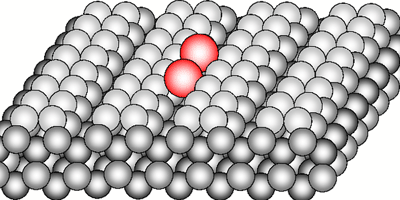The Opposite of Friction
The motion of paired particles (dimers) on a surface appears in a wide variety of different contexts, such as the layer-by-layer growth of a semiconductor or the hopping of molecules in an optical lattice. In Physical Review E, David Speer at Bielefeld University, Germany, and colleagues report a nonintuitive effect based on their calculations of the motion of a dimer of two identical particles on an isotropic surface: in spite of the intrinsic symmetry of the system, a periodic external potential acting on the dimer can cause a spontaneous symmetry breaking. This is reflected in the net motion of the dimer in a specific direction, which depends on the initial conditions. The essential condition for this effect is a non-convex interaction potential between the dimer components, such as one where the potential changes from repulsive to attractive with distance.
Speer et al. show that if a dimer is also subjected to thermal noise, it can exhibit a divergent diffusion constant at low temperatures – a counterintuitive result, given that the diffusion coefficient of a particle on a surface usually vanishes as the temperature goes to zero. Furthermore, under the action of a constant force, the dimer can have a “negative mobility,” where it moves in the opposite direction to that of the applied force. According to the authors, this behavior could be observed in a nanofriction experiment, where the friction force may be acting not against, but along the pulling direction – a phenomenon bearing some resemblance to so-called superlubricity. – Hernan Rozenfeld





